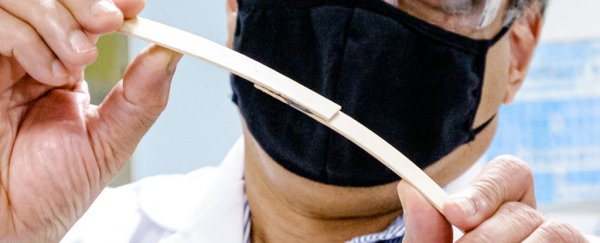A newly developed glue that gets its stickiness from a magnetic field could lead to serious energy and cost savings for companies that need to stick things together on an industrial scale.
To harden – or cure – the mix of chemicals in most epoxy-based glues, some kind of environmental effect like heat, light, or moisture needs to be applied.
Here, that's being achieved by a "magnetocuring" process, which is being promoted as an option for when conventional adhesives aren't particularly effective, or in heat-sensitive applications, or for when a lot of insulating material is involved (making it tricky to apply heat, light, or moisture).
The glue works by combining a commercial epoxy with custom-made magnetic nanoparticles that mix manganese, zinc, and iron: these nanoparticles heat up when electromagnetic energy is passed through them, fastening the materials in place.
"Our key development is a way to cure adhesives within minutes of exposure to a magnetic field, while preventing overheating of the surfaces to which they are applied," says materials scientist Terry Steele from Nanyang Technological University (NTU) in Singapore.
"This is important, as some surfaces that we want to join are extremely heat-sensitive, such as flexible electronics and biodegradable plastics."
The new glue is easier to apply, works faster, and requires less energy and space than conventional mixtures. It requires no hardener or accelerator, and can be tweaked to control the maximum rate and temperature of the heat as it's applied.
In the case of carbon fibre products like bikes and helmets, for example, large ovens are required to heat the materials over many hours to cure the epoxy glue. This innovative new solution, in contrast, requires a small electromagnetic device.
Specifically, the researchers say a gram of conventional epoxy glue needs an hour in a 2000-Watt oven to be fixed. A gram of the magnetocuring adhesive, in contrast, needs just 5 minutes in a 200-Watt electromagnetic device, which works out to be around 120 times less energy overall to finish the process.
"The curing of our newly-developed magnetocuring adhesive takes only several minutes instead of hours, and yet is able to secure surfaces with high strength bonds, which is of considerable interest in the sports, medical, automotive, and aerospace industries," says materials scientist Richa Chaudhary.
"This efficient process can also bring about cost savings as the space and energy needed for conventional heat curing are reduced significantly."
The newly designed process removes the risk of overheating and uneven heating, and can still reach a high adhesive rating of up to 7 megapascals – on a par with the adhesives that it's in line to start replacing. It's taken three years to get to this point, and the researchers are now looking for commercial partners to work with.
Wood, ceramics, and plastics have all been tested out with this magnetocuring process, which means it's versatile as well as very effective, and there are also ways it could potentially improve the speed of modern-day production lines.
Everything from sports equipment to aerospace components could be fastened together more efficiently with the new glue, the team says, and the benefits in terms of energy use and carbon emissions could be hugely significant, if the material can be scaled up outside of the lab.
"Our temperature-controlled magnetic nanoparticles are designed to be mixed with existing one-pot adhesive formulations, so many of the epoxy-based adhesives on the market could be converted into magnetic field-activated glue," says materials scientist Raju Ramanujan.
The research has been published in Applied Materials Today.
